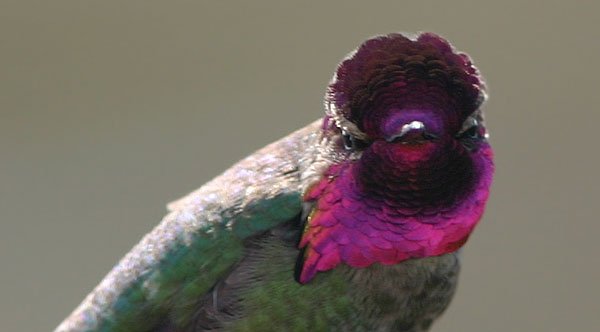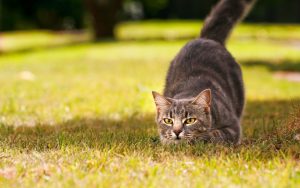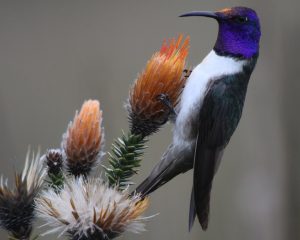
My friend Nina is an animal lover. All her pets are rescues. She keeps her cats inside. Unless she is accompanying her dog, he stays in a fenced-in area. She doesn’t use pesticides, she loves the local wildlife, and she does everything a good pet owner should do.
But one day, unbeknownst to her, a wild rabbit dug under the fence. She let her dog out, he spotted the rabbit, and took off like a bullet. Nina raced after him, screaming, but she couldn’t save the bunny.
Nina was distraught. “I keep my cats inside,” she texted me, “and my dog turns out to be the killer.”

She went on Facebook for consolation. Here was her first response: “Oh, so sorry. We have a cat that is a hummingbird murderer.” This was followed by, “I have one who is a chipmunk murderer.”
So: Nina is beating herself up over the fact that her dog, who is a pet and thus not a part of nature, has killed a wild creature – and people try to make her feel better by telling her their cats do it all the time.
I was tempted to go on Facebook with guns blazing, but right now I am forced to pick and choose the timing of my battles. This was the wrong time to get into a public fight.
My energy-saving strategy did not help me. At 2:00 that morning I paced furiously around my house, unable to fathom how mind-bogglingly cold and callous people can be. Since I am a wild bird rehabilitator and have seen, up close, the damage a cat can do to a bird, let me address the owner of the “hummingbird murderer.”
When your cat catches a hummingbird, the bird probably dies an excruciatingly painful death. This is entirely your fault. If the bird manages to escape she will still die, because cats’ claws and teeth are crawling with bacteria; one tiny nick and she will just die more slowly. This is also entirely your fault. If the bird has nestlings, they will all starve to death. This is also entirely your fault.

You are personally responsible for the agonizing deaths of possibly hundreds of birds per year. Question: how do you continue to pull this off?
I paced around my house that night, wracked with sadness over the deaths of so many beautiful, defenseless birds, furiously angry at people who bear complete responsibility, then joke about it and sleep like babies.
Outdoor cat owners, here’s how you can help me. Tell me: what is your secret? How can I become as cold and unfeeling as you are, so I can finally get some rest?
Anna’s Hummingbird by Mike Bergin; cat by Zastavski.com; Ecuadorian Hillstar by Corey Finger













Excellent post.
Thank you, Pat – there has to be some way to get through to these people!
Until five years ago, we had a cat that went outdoors. It was how we always did it when I was a kid growing up in the country. The more I learned about cats killing birds, I knew I couldn’t ever do that again. Now we have two indoor cats that we take outdoors into our garden on a harness. It works brilliantly. Some people build “catios” so cats can have an outdoor space that birds can’t enter. The radio show BirdNote is doing a great job gently educating people about the issue: http://birdnote.org/show/keep-your-cats-indoors
Hi Wendy, thanks for your link and for being such a good cat owner! I should do an entire blog on catios, the site you sent is a really good one. I’m glad there are places who try to “gently educate” people (that’s a good term). Personally, I’m past the point of gentleness, having been forced to deal with too many shredded birds and people who don’t give a damn. You never know which approach is going to work for which person, if at all.
I have 5 indoor cats. I am a kitten rescuer. I feel very strongly that the public needs more education on dumping cats, the cruelty to them, the harm they do and how simple the problem is to correct, I am also an Audubon member. A very large problem I see is the attitudes on both sides of the fence. Personally I find it disturbing to hear the uneducated, rash and awful comments made about cats – who are just creatures God created also. It creates distrust and an unwillingness to work together. When a raccoon or fox gets one of my chickens, I don’t kill the animal. I understand it is doing what it does. Perhaps bird lovers should adopt a feral, get it off the street and work to help education people in a noninflammatory way.
Annette, I applaud you that you rescue kittens and get them off the streets, and that all your cats stay indoors. And yes, you’re right, the issue is polarized. But raccoons and foxes are wild animals, cats are not. Even ferals are not wild animals – they are escaped or dumped pets. They’re not part of nature, and they’re decimating it. Personally I’ve found that speaking gently to cat people doesn’t work. The most success I’ve had in changing people’s minds about letting their cats outside was with my book “Flyaway,” in which I told true stories about people and their cats and what their kids learned from their parents’ lack of responsibility. I just can’t fit all that into a blog.
“Outdoor cat owners, here’s how you can help me. Tell me: what is your secret? How can I become as cold and unfeeling as you are, so I can finally get some rest?”
Not a cat owner, and I’ve successfully convinced a friend to make her cat an indoor cat, so I agree with you about the issue, but I still think the question is a little unfair. It can and has been argued that “natural” and an idea and ideal is a human construct, not an actual thing. Even if natural is a thing, there is basically none of it left, as at every stage of every ecosystem, we’ve changed what was and now there is something different. We live in the Anthropocene, where everything shifts in relation to us.
In that context, I can’t claim I understand why a cat killing a bird is a horrifying tragedy and a racoon doing so isn’t. What if the number of racoons has exploded due to trash raiding, does it become a tragedy then? It strikes me as slight arbitrary. To me the bigger concern is the bigger pattern (widescale loss of songbird over large areas, irrespective of the cause) than the specific individual stories.
I also don’t think its helpful to delineate so starkly between natural and non-natural. We need to remember that we are part of nature, more so now than even in the past. It’s only when we remember our fate is tied to nature’s are we going to find the needed solutions.
I know this is a quandary we all come across constantly. On the one hand, the visceral pain of witnessing cruelty born of ignorance is never-ending, and I’m constantly fighting to retain my equanimity in a world that often seems not to care.
On the other hand, in my own experience, getting angry, which is obviously my natural response, has the effect of putting people on the defensive and then I risk never getting through to their compassionate side.
Here’s the flip side of what can happen when people learn:
Year ago, I became a wildlife volunteer and advocate precisely *because* of a cat who caught a bird.
I was volunteering at an animal shelter, and came home one day to a stray of my own — one who would eventually become my cat, but who, up until that point was hunting the streets to survive.
I chased her down several times, and rescued the birds I could. You can imagine the sick feeling I had, as an animal lover and environmentalist, returning to the wildlife center with more than just that first bird. I’d rescued other injured animals throughout my life, but this time, I had to face those same volunteers with a personal connection to the carnage.
It was the reaction of the people at the wildlife center that transformed me. They didn’t judge me, even as I’m sure they were absolutely livid at the suffering created by this stray cat. They used their passion and kindness to invite me into their process. They showed me what bird would likely go through — if he or she survived. They gave me an intake number so I could follow her progress. And they invited me to the release, if it was practical (which it often isn’t).
Their love and commitment to the birds inspired me to take action as well. So, after adopting the kitty who became our beloved indoor cat (with outdoor ‘catio’ on our balcony), my husband and I promptly signed up for training at a wildlife hospital.
Obviously, that’s anecdotal, but I think the best thing we can do as wildlife advocates is to somehow get across, viscerally, to others what that experience is like for the bird, without distancing or judging. I don’t have the perfect technique, but at the root is always education, and graphic visual education really has an impact.
(And yes, I know there will always be people on this planet who just doing give a flying ____, or worse, engage in malice toward wildlife.)
Hi Duncan,
Re cats versus raccoons, if people who live across town from Mary leave their garbage out and it contributes to an increase in raccoon population, which then causes a decline in bird population, it’s hard to put the blame on Mary. However, if Mary lets her cat outside and the cat kills birds, contributing to the overall decline in bird population, that is directly Mary’s fault.
Individuals make up populations. If people brush off the individual stories, eventually the populations will decline. This is stereotypical rehabber-vs-biologist argument, which really shouldn’t be an argument at all, since we’re working toward the same goal.
I think natural versus nonnatural is a vital part of the argument to keep cats inside. Cat owners provide their pets with food and veterinary care. if a wild animal is injured or starving, the odds are good that no one is going to find him, rescue him, and rush to a vet.
I wish more people would remember that we are supposedly part of nature! These days it seems like a tenuous link at best.
Dear Ingrid,
What a fabulous story! I only wish this happened all the time.
There is no angle I won’t try in my attempts to convince people to keep their cats inside and stop maintaining feral populations. I’m going to try to find you on the internet. Stand by!
Cats and dogs and anything else “domesticated” are absolutely part of this natural world, just as much as we are. The solutions are population control and education. Humans by far create the most formidable impact on the natural world – plastics, pollution, environmental degradations. Responsible humans understand this impact and many of us do things to mitigate their footprint. I commend you as a Rehabilitator; I commend all who educate, conserve and do work to further conservation efforts and environmental stewardship. To the “cat” issue, it’s not just cats. I’m sure if you asked the farmer, she might say wolves or rabbits or deer, or the forest ranger might say humans and their campfires. I have three cats and one dog, and my pets love being outside when I’m home and permit them the time and treat to be out in nature (our backyard), I dare say as much as I do. Catios are a great option if you have the resources or want that type of environment, I also have my cats wearing Birdsbesafe collars. I also use squirt bottles and the hose, if I see one of my pets stalking. You can create a play pen area for pets – I’ve seen screened enclosures for your yard, pet strollers, etc. .
Melinda, thanks for your environmental awareness…catios, screened enclosures, harnesses are all great ways to let cats enjoy the outside but keep both the birds and the cats safe. Birdsbesafe collars are better than nothing, but they’re not the answer, especially in the springtime. Fledglings just don’t have the skills to get away from a cat, whether or not it’s wearing a bright collar. Here’s more on that https://www.10000birds.com/?s=birdsbesafe+collars